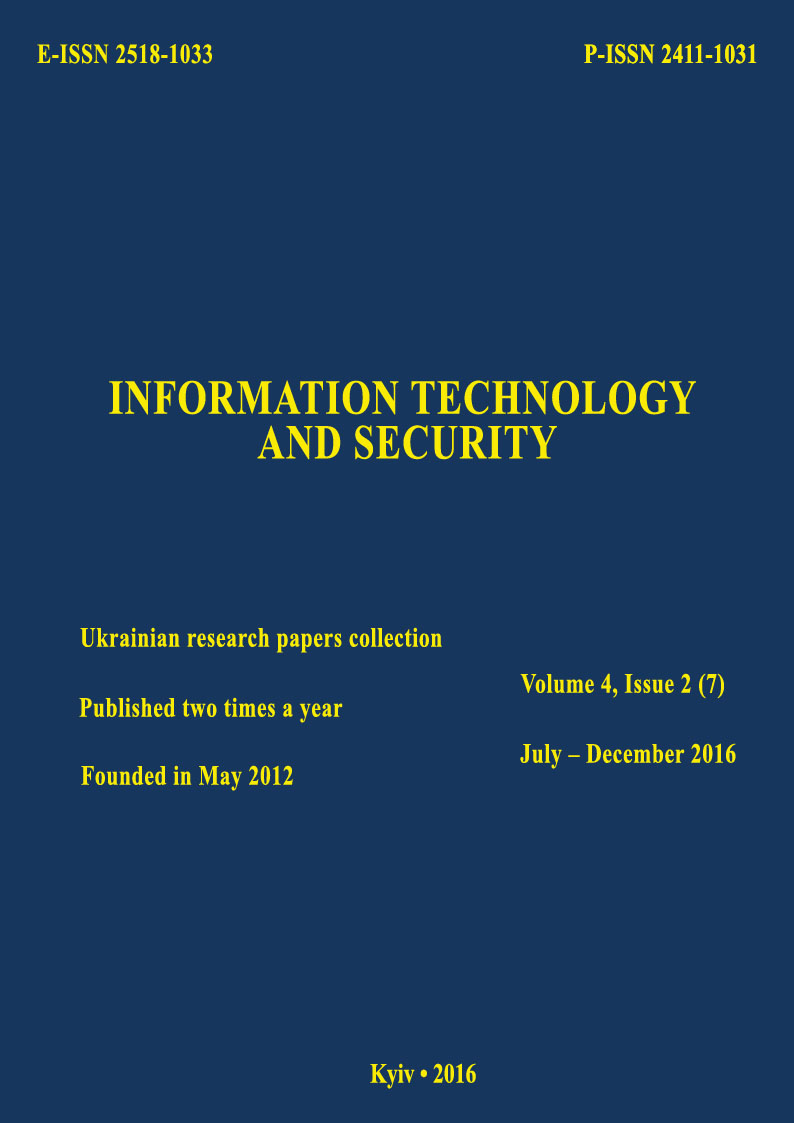Hardware-software realisation of the generator of subkey based on the cellular automata
DOI:
https://doi.org/10.20535/2411-1031.2016.4.2.109993Keywords:
Encryption, video, cellular automata, Field-Programmable Gate Array.Abstract
This article describes approaches and the basic problems of existing methods of encryption methods – low reliability of information protection and low speed of their implementation. Is described the method of encryption of videodata based on cellular automata, which allows to raise reliability of protection of a videoinformation, to increase length of a key of encryption, to raise speed of encryption images and to simplify preparation of initial parameters for the subkeys formation block. According to aforementioned method, the image that you want to encrypt, digitizes and submit to the encryption block in distorted form. This form is due to the law given scan, which belongs to the key data. The encryption block uses subkeys, which generate by special structure, implemented on two cellular automata. The main cellular automata transmits excitation signal from cell to cell and additional cellular automata carries alteration of all its cells under a given function and selected neighborhood. Is described software and hardware implementation of subkeys generator for video encryption system, which is based on the aforementioned method. This generator is implemented using two cellular automata, which allows you to create key gamma in implicit form. The additional cellular automata operate at every cycle time so that all its cells perform XOR operation on signals from the cell neighborhood and its own state. The state of the main cellular automaton with each successive clock signal can change in a single cell, which at the time clock was excited. Also excited cell goes dormant and cell neighborhood, which passed excitation signal, becomes excited. Information signal from cell of cellular automata goes to output only when the cell is in an excited state. Gamma depends on the initial map state of cellular automata and initial settings of trajectory. The generator is implemented on low-cost FPGA with high performance, which allow encrypting videoinformation in real time in the transmission of the communication channels.
References
A. Volodin, V. Mitko, and E. Spinko, “Video signal encryption – developer workshop”. [Online]. Available: http://www.chipinfo.ru/literature/chipnews/200103/ 2.html. Accessed on: Sept. 10, 2016.
G. Basalova, “Encryption, noise-immune encoding and information compression”. [Online]. Available: http://www.intuit.ru/studies/courses/691/547/lecture/ 12397. Accessed on: Sept. 10, 2016.
S. Wolfram, “Cellular automata”, in Cellular Automata and Complexity. [Online]. Available: http://www.stephenwolfram.com/publications/cellular-automata-complexity/pdfs/ cellular-automata.pdf. Accessed on: Sept. 10, 2016.
M. Bruno, and P. Sole, “Pseudo-random Sequences Generated by Cellular Automata”, in Proc. International conference on ralations, orders and graphs. Interaction with computer scince, Mandia, Tunisia, May 2008. [Online]. Available: https://arxiv.org/abs/0807.3865. Accessed on: Sept. 10, 2016.
S.V. Valov, A.Ia. Olkhovskii, O.A. Pavlov, Iu.F. Pakhomov, and V.G. Starodubtsev, “Speech signals encoding and decoding device”, RU Patent Appl. 2050698, Dec. 20, 1995.
Yu.B. Rytsar, M.P. Kozlovskyi, M.V. Shovheniuk, S.V. Voloshynovskyi, and Z.D. Hrytskiv, “The method of visual information securing”, UA Patent Appl. 22285, June 15, 2001.
V.V. Mokhor, S.M. Bilan, and A.A. Demash, “The method of securing visual information”, UA Patent Appl. 99465, June. 10, 2015.
A.V. Iakovenko, V.V. Larin, and R.V. Tarnopolov, “Approaches for protection vydeoynformatsyy based on Elimination of redundancy in ynfokommunykatsyyah”, Modern special equipment, no. 2 (37), pp. 82-89, 2014.
I.L. Erosh, A.M. Sergeev, and G.P. Filatov, “Protection of images during transfer via communication channels”, Information and Control Systems, no. 5, pp. 20-22, 2007.
L.A. Mironovskii, and V.A. Slaev, Strip method of images and signals transformation. Saint Petersburg, Russia: Politekhnika, SPb, 2006.
L. Tang, “Methods for encrypting and decrypting MPEG video data efficiently”, in Proc. of the fourth ACM international conference on Multimedia, Boston, USA, 1996, pp. 219-229.
doi: 10.1145/244130.244209.
H. Cheng, and X. Li, “On the Application of image Decomposition to Image Compression and Encryption”, in Proc. of the IFIP TC6/TC11 International Conference on Communications and Multimedia Security, Essen, Germany, 1996, pp. 116-127.
doi: 10.1007/978-0-387-35083-7_11.
T. Kunkelmann, and U. Horn, “Partial Video Encryption based on Scalable Coding”, in Proc. 5th International Workshop on Systems, Signals and Image Processing, Zagreb, Croatia, 1998, pp. 215 – 218.
S. Bilan, and A. Demash, “High performance encryption tools of visual information based on cellular automata”, Information Technology and Security, vol. 4. iss. 1 (6), pp. 62-75, January-June 2016.
Downloads
Published
How to Cite
Issue
Section
License
Copyright (c) 2020 Collection "Information technology and security"

This work is licensed under a Creative Commons Attribution 4.0 International License.
The authors that are published in this collection, agree to the following terms:
- The authors reserve the right to authorship of their work and pass the collection right of first publication this work is licensed under the Creative Commons Attribution License, which allows others to freely distribute the published work with the obligatory reference to the authors of the original work and the first publication of the work in this collection.
- The authors have the right to conclude an agreement on exclusive distribution of the work in the form in which it was published this anthology (for example, to place the work in a digital repository institution or to publish in the structure of the monograph), provided that references to the first publication of the work in this collection.
- Policy of the journal allows and encourages the placement of authors on the Internet (for example, in storage facilities or on personal web sites) the manuscript of the work, prior to the submission of the manuscript to the editor, and during its editorial processing, as it contributes to productive scientific discussion and positive effect on the efficiency and dynamics of citations of published work (see The Effect of Open Access).

